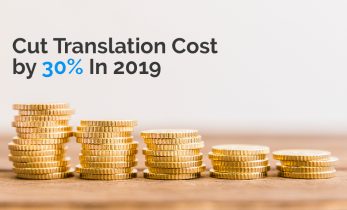Greater than 8 minutes, my friend!
Marketing Localization: translation, transcreation or copywriting? Choose the best localization strategy for your online business
As a consumer of goods and services, I use my iPhone to read about everything I buy: from a book, to a cream, a pair of shoes or a new course. If I can’t find online information or reviews, I don’t purchase. Why? When I google my desired product, I get a lot of suggestions with similar offers from other online businesses.
Like everyone else, 99.9% of the times I only look at the Google search results that rank high enough to be displayed on page 1. As mentioned in a recent article on The Open Mic, the best place to hide is on page 2 of Google.
But what gets a product ranked on the first page of Google? Nowadays, it’s good quality content.
This is how it works.
A PANDA, A PENGUIN AND A HUMMINGBIRD
Until some years ago, the highest ranking content in the Google search results was ghost web pages and articles with no value for the reader. As a consequence, Google decided to introduce 3 algorithms, which changed the way we search information online: Panda, Penguin and Hummingbird.
- Panda was released in 2011 and targets low quality content or so called content farms: websites that produce a high amount of irrelevant content, that ranks well by sheer volume and no quality. Panda penalizes these websites by sending them at the bottom of the search results. Something like page number… who cares? I don’t scroll all the way there.
- Penguin was released in 2013 and targets black-hat SEO techniques, like manipulating links to get a better index in the Google search results. The techniques are: guest blogging, link badges or low-quality directories. With the Penguin in action, such techniques land websites, again, where no one ever scrolls.
- Hummingbird was released in the autumn of 2013 and is used for semantic search. This algorithm puts a Google search in context: it wants to give the best answer to a query. Hummingbird benefits both the reader and the pages with high quality content. Happy Google searching!
In conclusion, what you need for a successful online presence is to:
- Create good quality content that is relevant for your audience
- Work on your keywords
- Outplay your competitors
To achieve this, you don’t need a good content strategy. You need the right content strategy. And this applies to all your content in all your languages.
Very little businesses think about localization strategy when they launch in a new market. Preparing a website for a market entry is intense work, and many people want to take the shortcut on localization. The content is sent for translation in bulk and with a tight deadline.
But, you reap what you saw. A translator or an agency will try their best to translate your texts correctly. But if you don’t get them on board with your content strategy, the results will not meet your expectations.
How can you avoid this?
MARKETING LOCALIZATION
Marketing content is the content you produce for your online business: website, product, legal and help texts, online marketing, CRM and social media campaigns.
The goal of your marketing content is to attract the attention of a potential customer and keep it long enough for a purchase to happen. The secret is to create your content strategy and tweak it over and over until it brings the desired result. This is an agile approach to content creation that works.
But don’t stop there: do the same for your content localization.
Before you start localizing, stop for a moment to think which translation technique is suitable for which type of content. You have 3 options: translation, transcreation and copywriting. Each option will bring you a different result and will require a certain input from you, as a requestor.
TRANSLATION
In many cultures, the word translator is associated with the word traitor. I find this fascinating and always wondered why it is the case. Let’s take a closer look at what translation does.
Translation is the basic act of transporting information from one source language into a target language. Its role is facilitating communication between people who don’t speak the same language. But what is the role of the translator in this communication act? Is she a neutral language switch that takes the input in one language and makes the output in another language?
One of the most famous translators in history, La Malinche, is credited both with being a traitor and the mother of the modern Mexican nation. Whatever her intentions were, the role played by La Malinche in the Mexican Conquista is indisputable. Every historian agrees that, without her translation work and knowledge of the local cultures, the Conquistadores would’ve been lost.
The controversy around this iconic figure is so big, that artists and writers see her as a source of inspiration even today. A neutral language switch cannot ignite such a national debate for five centuries.
Next time you request a new translation, remember this: your translator is not a neutral language switch. If you don’t want your translator to be a “traitor”, make sure to brief her properly about your business strategy and intentions.
For which type of texts you should choose translation
Informative texts are the most suitable for translation. These are texts that contain little to no SEO wording and don’t try to persuade the reader to take action. Make sure that the information you provide, though, is valuable enough for your audience to read.
Let’s take a website as an example. The content types that you should translate are: resource strings, error messages, legal texts, payment descriptions, account and registration content, FAQs and help texts.
While the translation will not be done word-by-word, it needs to be as close as possible to the source text.
What you should know
Give your translator the right context for your project, if you don’t want her to make an educated guess. Don’t simply send a file per e-mail with the instruction: “I need these texts translated into Finnish”. Brief the translator about your business, brand, strategy and intentions.
Terminology
Instruct the translator to choose the terminology with the best Google search results in the target language. If you have an in-house SEO team that already did the terminology research, send the results to your translator.
TRANSCREATION
The concept of transcreation comes from poetry translation and was first coined by Haroldo de Campos, a Brazilian poet and translator. De Campos named transcreation also translation recreation or parallel translation.
In translation, the focus is on the meaning of the source text. In transcreation, the focus is on the aesthetic information of the source text, while meaning takes the secondary role of defining the boundaries of the recreation act.
Within these boundaries, the translator has all the liberty she wants to rewrite the source text into the target language. Metaphors and cultural references will be adapted; sentences and paragraphs may be changed, as well as punctuation and the length of the texts.
The result is an independent target text that can be perfectly mapped to the source text because they are part of the same system.
For which type of texts you should choose transcreation
Taking again a website as an example, the texts most suitable for transcreation are product and service descriptions. These texts have an informative-appellative function and should make the product or service attractive to the potential customer.
Unlike informative texts, such as resource strings or FAQs, marketing descriptions appeal to the senses of the audience, their dreams and desires. Therefore, a very culturally specific language needs to be used.
What you should know
Because transcreation is the act of recreating a source text in another language, you need to define the boundaries of the recreation act. It’s important, not to create false expectations by giving false information to your audience. Providing adequate information about your product or service to your translator helps you prevent this.
Use a Localization Kit to gather all the relevant details and take extra care when defining your brand identity, tonality and target audience in the new market. Provide a thorough description of your product or service and of your marketing strategy.
The questions to answer are:
- How do you position yourself in the market?
- What makes your product or service unique?
- How do you want to present your product to your new audience?
Don’t forget to create a small terminology glossary with the proper names that you don’t want localized, including the correct way to write them.
Terminology
This is the content where you will use your SEO strategy. Provide the translator with detailed information about your SEO goals: which SEO terminology should she use, where and how often? If you already did the SEO terminology research, send the keywords to your translator.
COPYWRITING
If you want to sell your product internationally, you need to keep two things in mind:
- Even though market segmentation is universally applicable, no two audiences are the same.
- With a plethora of online products and services, you need to tell your story the way your audience wants to hear it.
Copywriting is the most overlooked localization technique, yet the most effective for marketing campaigns. Many translators and agencies use transcreation for this type of content. But transcreation is not suitable, because it focuses on recreating the source text in a new language.
With marketing campaigns, the focus is exclusively on the target audience.
In the end, if the only reference the translator takes from the source text is the layout, proper names and placeholders, than this is not called transcreation anymore but copywriting.
For which type of texts you should choose copywriting
Choose copywriting as a localization technique if you plan to launch or already have a dedicated brand in an international market and this market is important to you. Any type of CRM campaign, online marketing text or add, banner, teaser, TV spot, push notifications or social media content are good candidates for copywriting.
What you should know
For writing good marketing copy, thorough research of your target audience and a detailed documentation of your requirements are a must. You will need to use a briefing to inform your translator in detail about what is needed.
What you should include in your briefing:
- What is the purpose of your campaign?
- Who is your target audience?
- What image do you plan to use for the campaign?
- Do you have a promotional offer?
Apart from the purpose of the campaign, you should specify the layout, the different elements that should be included in the copy, such as title, body text, call to action and character limitations. In the case of a mailing, include subject line, pre-header, salutation line, the length of the body text and any placeholders you need to use.
A lot of thought goes into planning a marketing campaign. Share your ideas and thoughts with your translator and help her write the best marketing campaign for you.
Terminology
Since these are texts where you want to speak the language of your audience, you should instruct your translators to do an online research of your type of product and service in the target language. Forums and reviews are the best source of inspiration. This is where your translator can learn how your audience talks about your type of product and use the same terminology and style.
CONCLUSION
Content localization is a must for anyone who wants to stay competitive in a growing global market place. And choosing the right localization strategy is key to successful online business.
Apply these 3 content localization techniques to rank high in the online search engines and to write appealing marketing copy that persuades your audience to take action. When choosing the right localization technique, your reference is your audience and what you want them to do with your content.
The formula is simple: if you want to inform them use translation; if you want to appeal to their senses use transcreation, and if you want to persuade them use copywriting.





Claudia, you’re so resourceful! This new comprehensive guide to localization benefits both translators and clients!
Hi Eleonora, good to hear from you!
This is a topic I’m very passionate about. I believe that a good localization strategy and a close collaboration between client and translator is the key to good quality content. It’s very hard work, but it’s possible.
That is a great article. So well explained, and with great hints on how to do each one.
Thanks Claudia!
Hi Mariana, thank you for taking the time to comment. I really appreciate it 🙂
I tried my very best to create some order in my head, first, and than on the page. I am happy to hear that my efforts paid off. Writing is tough business…
Thank you for the useful article, Claudia. The part about three Google algorithms (and their names) was totally new to me.
Hi Oleg, thanks for your comment and for reading the article. 🙂
It’s indeed very interesting knowing how content is indexed by the search engines, right? It helps us better understand the requirements for the content we localise. And ask the right questions when we get a new localization request.
An informative article that breaks down the different types and styles of translation with digestible explanations. I especially appreciated your descriptions of the difference between translation and transcreation.
Coming from a marketing agency background where I created art and copy for campaigns, the copywriting section of the article was very familiar but well written. I hope that others, who are more new to marketing, use the strategies you outlined in their professional projects.
Hi Nicole, thank you for taking the time to read the article and for your kind words.
The idea of copywriting as a localization technique is still quite new in the industry. I’m still learning myself. There’s a huge difference between getting an already written text and doing something with it, as opposed to creating a text from scratch based on a briefing.
Also at a management level. It involves more work.
But the results are great! And there are talented translators out there who can also write really good marketing copy for international markets.
A must read article for every localization strategist! Thanks Claudia.
Hi Alexey, thanks for reading the article and leaving a reply.
The requirements for the localization industry are more and more complex, because businesses need to be competitive in order to survive. And this can be done only by attracting and keeping their clients happy and engaged with good content.